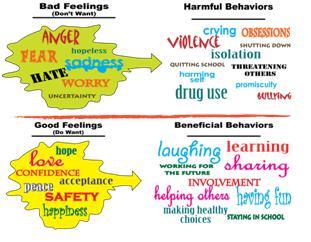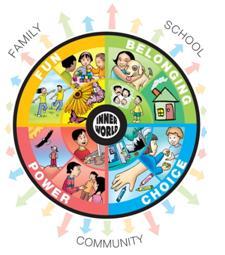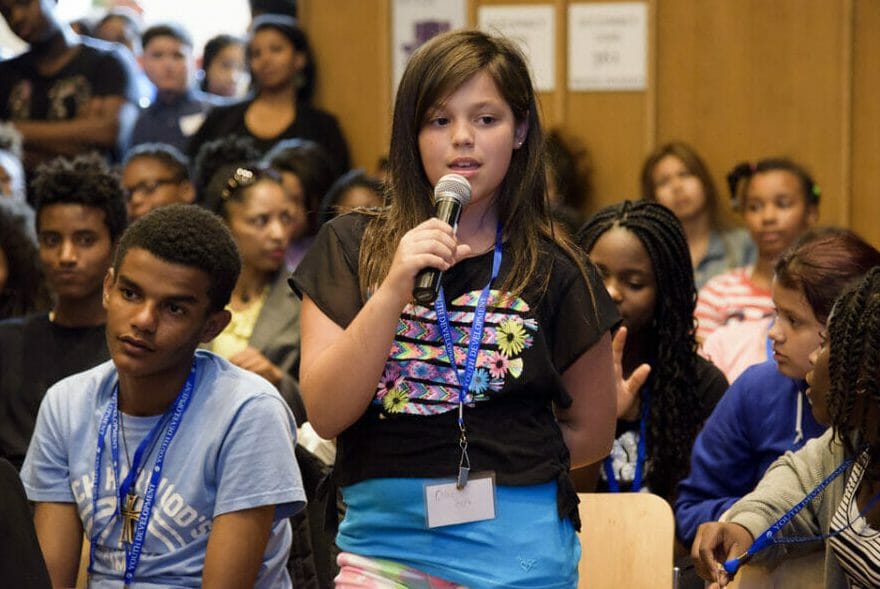 Teachers can make the classroom a happy environment for children by addressing the basic needs based on the choice theory and making sure kids have a choice.
Teachers can make the classroom a happy environment for children by addressing the basic needs based on the choice theory and making sure kids have a choice.
In previous blog posts on choice theory, I explained William Glasser’s theory that everything we do in our life is a result of our choice. It is applicable to parenting, business, management, and relationships. It is very applicable to education and the way classrooms are designed.
Unfortunately, most classrooms are not places where one can be free to follow the basic needs based on the choice theory.
- Need of survival – Most kids are very scared and afraid in relation to their schooling. They see their teachers as an authority that evaluates them and sends the evaluation to their parents to punish them if they don’t fulfill the parents’ expectations. School is very much a jungle. Based on social norms in their specific schools, if they won the smart lottery, they are at the top of the chart. If they weren’t born smart (or sporty, depending on the school’s criteria), they are at the bottom. Whether your classroom will be happy or not depends on your luck.
- Need to belong and be loved by others – Belonging is not part of the schooling system. There is more competition in class than a sense of community. If kids have different houses in sports, they are not a school community but in competition with other houses. In the past, teachers were able to share their loving feelings with the kids. Nowadays, they are to refrain from touching, hugging, or showing love to the kids.
- The need to have power and importance – Kids have no power in school. They don’t choose the school, the teacher, and, many times, not even the kids in their class. Marking is the system’s way of taking power from them and they are constantly reminded that they are just one out of 30 kids in the class with no special circumstances. (Not if they are smarter or need more stimulation or need extra help.) The system’s aim in making them ‘the same’ is the most debilitating act and it is done through the expectation for them to perform the same and dress the same (especially in schools with a uniform policy).
- The need for freedom and independence – Kids do not have freedom in class. They learn obedience and have no choices. They can’t choose not to do their homework—not even to go to school or not. If they don’t follow the rules, they are punished. They can’t evaluate themselves and they think of themselves based on what their teachers tell them.
- The need for fun – If you ask kids about school, they would not say it was fun, which is a sad thing because fun is one of the best motivating factors in learning. When kids complain about the hard work, they are told that school is not the place to have fun. It is a place to learn, as if there is a contradiction between the two.
I enjoyed my teaching and my students throughout my career (28 years almost) only because I made sure I created a classroom or an academic program that fulfills all those needs. Every teacher can.
Tips for Teachers
- Every behavior is a result of an attempt to fulfill the basic needs. If a kid is not behaving in a way that seems right for you, don’t be tempted to use the deadly habits. Ask yourself, what need is not fulfilled out of the five?
- Your most important goal is to help kids develop intentional friendship and make the students in your class, together with you as a leader, a community.
Glasser developed some skits to help teachers learn the basic idea of the choice theory. Here are two of them:
 Scenario 1: The Coaching Teacher
Scenario 1: The Coaching Teacher
A student calls out a lot in class, interrupts, and is difficult to motivate.
You don’t shame the student or punish him for his interruption. Rather, you want to know what is the connection he is missing, what need is not fulfilled.
You ask the student to come back in his own time to discuss the situation. When you give him a choice, “in your own time,” you give him control. He can choose. You give him power.
The student turns up. You thank him for arriving (as a sign of respect and appreciation) and ask him what was going on in class. (You ask it without judgment. You really want to know and turn your ears to listen.)
The student replies, “You never answer my questions.” Don’t be tempted to find the reason you didn’t reply to his question. Don’t justify or blame anyone else. Instead, find the need. You could reply with, “It sounds like you want more attention from me. What are you doing in class to get my attention?” This will validate the feeling and help the student evaluate his methods. Still, do it without judgment. Make sure your tone is not sarcastic in any way but loving and accepting. Do not corner him to say he was interrupting. If he can’t identify in the first round, ask him, “Let’s try to find a way together for you to get my attention.” The more you listen, the more caring you are. Remember the four questions:
- “What do you want?” Or a version of it can be, “You have my attention now. Is this what you wanted?”
- “What are you doing to achieve what you want?” Or “How’s your behavior in class working for you?”
- “Is it working?”
- “What are your plans or options?”
Later on, after having an agreement with the kid, you can say, “You have agreed. I thought you wanted to . . .”
Make sure the responsibility is on the student to do the best for himself. Pleasing you is not the right motivation.
Scenario 2: The Quick Shifter
Some kids only need something small to shi
Tips for strengthening teachers’ choice muscle
- Ask the students to have a say in the way they learn. Give them options and let them choose.
- Share with your students your feelings and thoughts about the seven deadly habits and seven caring habits. It will make you transparent and real to them. Ask their opinion and let them offer examples.
- Use the choice theory questions often – I find the questions really helpful. It places the responsibility back on the student to find a solution. It also identifies that the student has made a choice with his or her behavior.
- Dedicate time to explore the concept of “choice” and help kids focus on things within their power – The past, for example, is one things we don’t have any control over, nor who our parents are and other things that kids have no control over (which city to live in, how much money they have, the size of their house). We still have a choice to react to it well, but not to change it.
- Teach interpersonal skills – It is your job to make sure they communicate well with each other.
- Teach them problem-solving techniques – They may not be perfect at first, but conflicts will be part of life and they will get better as their choice muscles strengthen.
- Avoid teaching memorizing but more critical thinking – There is a limit to our memory cells but never a
limit to our thinking ability.  Teach your kids to seek help when they need to – It is one major aspect of EQ. Recognize that we need help and manage it by asking for help. Be there to help. Offer help and ask, “Would you like my help?” or “If you need help, come and I will help you.” In therapy, we say that when we know the kids are facing a difficult time and we cannot reveal the source. We can say, “I am here if you need me.”
Teach your kids to seek help when they need to – It is one major aspect of EQ. Recognize that we need help and manage it by asking for help. Be there to help. Offer help and ask, “Would you like my help?” or “If you need help, come and I will help you.” In therapy, we say that when we know the kids are facing a difficult time and we cannot reveal the source. We can say, “I am here if you need me.”- Come up with self-evaluation strategies to help kids evaluate their own work – I have done the self-marking system and it was amazing how honest and accurate the kids were. If there was not a match between what I thought and the student’s self-evaluation, I knew it was something I needed to check. It was always a sign for me that I didn’t connect with this child well.
- Use your manners and say “please” and “thank you” a lot to model respect. Never use “please” and “thank you” in a sarcastic way. It is not respect. It is violence.
- Make the learning fun – Find games and fun activities that teach the same things taught from endless repetition, reading, and listening. Use the five senses to make it memorable and fun. Kids remember exciting things for years. I have used games to teach, even with my university students, and it works like magic. Easy to retain the information when fun is involved.
Join me next time when I summarize the difference between the caring teacher and the deadly teacher.
Until then, happy teaching!
Ronit

 Teach your kids to seek help when they need to – It is one major aspect of EQ. Recognize that we need help and manage it by asking for help. Be there to help. Offer help and ask, “Would you like my help?” or “If you need help, come and I will help you.” In therapy, we say that when we know the kids are facing a difficult time and we cannot reveal the source. We can say, “I am here if you need me.”
Teach your kids to seek help when they need to – It is one major aspect of EQ. Recognize that we need help and manage it by asking for help. Be there to help. Offer help and ask, “Would you like my help?” or “If you need help, come and I will help you.” In therapy, we say that when we know the kids are facing a difficult time and we cannot reveal the source. We can say, “I am here if you need me.”










